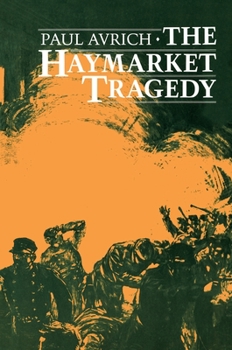The Haymarket Tragedy
Select Format
Select Condition 
Book Overview
This is the first paperback edition of a moving appraisal of the infamous Haymarket bombing (May 1886) and the trial that followed it--a trial that was a cause c l bre in the 1880s and that has since been recognized as one of the most unjust in the annals of American jurisprudence. Paul Avrich shows how eight anarchists who were blamed for the bombing at a workers' meeting near Chicago's Haymarket Square became the focus of a variety of...
Format:Paperback
Language:English
ISBN:0691006008
ISBN13:9780691006000
Release Date:May 1986
Publisher:Princeton University Press
Length:556 Pages
Weight:1.96 lbs.
Dimensions:1.4" x 6.0" x 9.1"
Customer Reviews
3 ratings
A Labor Riot and a Reactionary Miscarriage of Justice
Published by Thriftbooks.com User , 16 years ago
This is the definitive account of the Haymarket riot and the trial of the anarchists who were arrested for inciting the resulting riot that resulted in the deaths of several police officers. Had the police not attempted to disperse the crowd in such a heavy handed manner, it is most likely that no outrage would have occurred at all. Despite their radical views, the labor activists and political agitators who were put on trial for the Haymarket bombing were simply scapegoats. The actual bomb thrower was never apprehended. The farcical trial was conducted in a circus like atmosphere that could be best characterized as mass hysteria. Governor John P. Altgeld eventually pardoned the remaining Haymarket prisoners, but several of their fellow defendants had already been executed before Altgeld took office. One unexpected surprise that I discovered after reading this book is that one of my close friends is a lineal descendant of former Chicago Police Superintendent Frederick Ebersold.
anarchism on trial
Published by Thriftbooks.com User , 19 years ago
Avrich details the events of the Haymarket affair, which devastated the anarchist community in 1886. On May 4, 1886, anarchists and workers conducted a meeting in Haymarket Square. They protested the police shooting of striking workers at the McCormick Reaper Works. At the conclusion of demonstration, police interrupted the last speaker and told crowd to disperse. A bomb was thrown at the police and exploded. The police opened fire. Over sixty casualties were reported, including the deaths of seven police officers. The press, business community and politicians provoked a Red Scare. Nine Chicago anarchists were accused. One fled the country. One turned states' evidence. At the trial, the prosecutor presented evidence to sway the jury by concentrating on the background of the defendants, without proving the state's case. The judge further prejudiced the proceedings to ensure a conviction. After the trial, one man committed suicide. One received a lengthy prison sentence. Six were condemned to die. The governor of Illinois commuted two of their sentences to life in prison. Four were hanged. The outcry against this incident inflamed American and European liberals and radicals. Avrich documents this information in meticulous detail. He offers biographies of all the individuals involved in the incident, including the condemned men, their families, the prosecution, the defense, and other related anarchists and socialists. To provide a background for the incident, he traces the development of the anarchist movement in the United States and explores its ties with socialism. He evaluates the doctrines of the anarchists, who organized in the International Working People's Association. Anarchists desired an alternative society based on freedom, brotherhood, and equality against the forces of privilege and authority. They espoused violence as the means to bring about this revolution, because bourgeois capitalists would fight to retain their power. Based on this material, Avrich offers several conclusions about the incident and its influence on American society. He asserts the police instigated the violence, because they disrupted a peaceful demonstration, and by their random shooting of people. Avrich contends that the anarchists were convicted because of their social and economic beliefs rather than because of hard evidence. The trial concluded that none of the seven men could have thrown the bomb. The trial revealed the inequalities of capitalism and the limitations of American justice. He concludes that the affair inspired liberal activism and revealed the inequalities of the American capitalist system.
Avrich is the premier historian of Anarchism
Published by Thriftbooks.com User , 27 years ago
This history of the Haymarket affair traces the lives and development of the principles in the drama from their earliest exposure to the labor movement, socialism, and anarchism and up to the tragic bombing in which they were falsly accused and ultimately executed. What makes Avrich special is in the way he does not shy away from the uncomfortable truth while strill retaining the idealistic values of the players in this tragedy. He does not portray the men who were executed after the Haymarket bombing as lambs, but demonstrates their intense, often militant struggle. It was a violent time. At the same time, he explains the motivations of these men, especially Albert Parsons, in such a way that one wonders what other course could they have taken. The stirring explorations of Parsons' development from civil war vet to committed advocate of the working class does not idolize the man, but casts as heroic the struggle for justice and the loving and rich culture that produced the early figures of Anarchism. Avrich is the most well known and effective mainstream historian of Anarchism. His book on Sacco and Vanzetti is even more powerful than the Haymarket book, and his Anarchist Portraits and Anarchist Voices are essential primary sources





